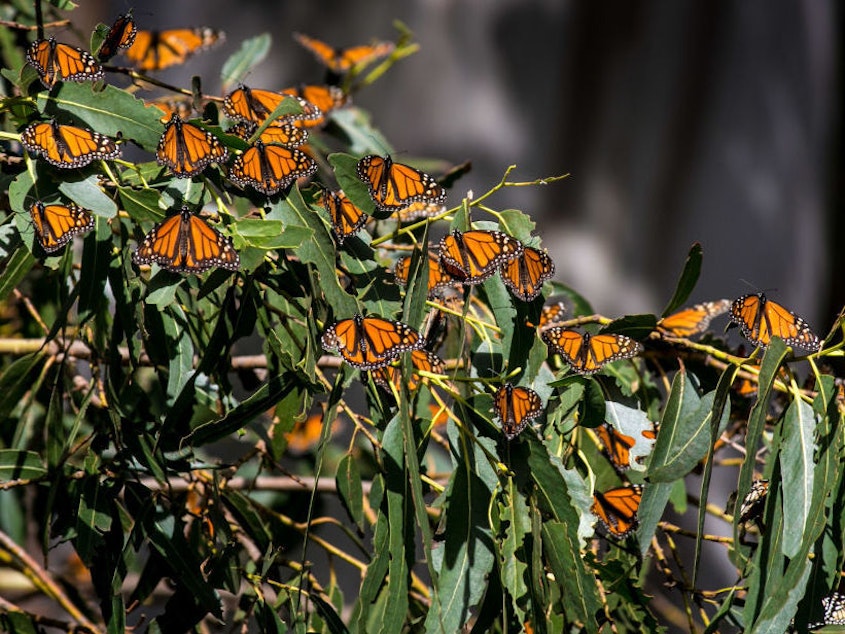Monarch Butterflies Born In Captivity Have Trouble Migrating South, Study Says

Three summers ago, Ayse Tenger-Trolander, a graduate student at the University of Chicago, ordered a batch of monarch butterflies from a breeder, and made an accidental discovery: the butterflies had likely lost the ability to migrate.
Tenger-Trolander studies the genetics and internal biology of migratory monarchs, and she had ordered the butterflies from a breeder that supplies butterflies for educational settings, with the goal of speeding up her experiments. "We fully expected ... that even though they've been bred in captivity, they're still normal North American monarchs," says Marcus Kronforst, her advisor at the University of Chicago.
To their surprise, the breeder's butterflies had rounder, smaller top wings - similar to nonmigratory butterflies. When they were put in a flight simulator, they did not orient south, unlike the wild North American butterflies they'd been raised alongside. The captive-bred butterflies, the scientists realized, were unlikely to migrate. Their findings are published this week in the journal PNAS.
The North American monarch butterfly spends summers in the United States and southern Canada. In the fall, the population east of the Rocky Mountains flies some 3,000 miles south to Mexico for the winter. West of the Rockies, monarchs roost in Southern California.
The monarch population has declined more than 80% in the past 20 years, and the U.S. Fish and Wildlife Service is considering them for the endangered species list.
Hobbyists and educators have responded by raising and releasing butterflies. They find caterpillars outdoors, or order them online. They keep them in tabletop tents, feed them handpicked milkweed, and nurture them from caterpillar to chrysalis. They tag newly hatched butterflies with stickers and release them, "hoping that they or their offspring will fly south to Mexico and ultimately contribute to population recovery," the study authors write. But there are issues, they say, with releasing captive, potentially nonmigratory butterflies into the wild population.
Karen Oberhauser, a monarch butterfly researcher and director of the University of Wisconsin-Madison Arboretum not affiliated with the study, has major concerns around releasing nonnative butterflies. "Under a best-case scenario, they don't have any negative impact on the wild population," she says. But, she worries that if they breed with wild butterflies, the offspring might be less inclined than wild monarchs to migrate. They might also introduce new diseases to wild butterflies.
Oberhauser also notes that "the fact that they're often released in places and times they wouldn't normally be there" is problematic. It's a dead-end situation for the butterflies, and a complication for researchers. "When we see a butterfly, we don't know if it's gotten there because somebody has released it, or if it got there naturally," she says.
"The findings in this paper are really interesting, and they're not unexpected," says Chip Taylor, emeritus ecology professor at the University of Kansas and director of Monarch Watch, who is not affiliated with the paper. Migratory behavior in monarchs, he notes, is "a very, very fragile part of the system, and it's easily broken." Past studies have shown that monarchs use the sun and the Earth's magnetic field to help them stay on course, but "we don't yet have a good understanding of all the cues that monarchs use."
Nonetheless, Taylor says, "that doesn't mean that [both captive and wild] monarchs don't get to Mexico." Monarch Watch tracks butterfly migration, and recently found several monarchs, sourced from a different commercial breeder and released at a festival in San Antonio, that made it to overwintering grounds in Mexico.
One limitation of the paper, Oberhauser and Taylor both point out, is that the butterflies tested are from one commercial breeder. Tenger-Trolander does not name the breeder in her study, but describes it as a major company that breeds monarchs year-round, and supplies them for weddings and educational settings. Her analysis suggests that this company's monarchs either lost their migratory behavior over successive generations of inbreeding, or were at some point crossed with nonmigratory butterflies.
Taylor, whose Monarch Watch organization sells home-rearing kits that come with caterpillars, says that most breeders are aware of potential issues that come with inbreeding, and regularly add wild stock to their captive populations.
Butterfly researchers say that raising monarchs helps butterflies indirectly in that it makes people care about them. "The real reason for raising monarch butterflies is for the enjoyment, the education," says Taylor. But the idea of individuals saving caterpillars as "monarch rescue" is misguided. "That's simply not going to work as a way to boost the population," says Taylor. "What we really need to do is to improve that habitat."
Many experts agree: To help the butterflies, focus on growing habitat. "Monarch caterpillars eat milkweed, but as adults it's really important that they have access to plants that flower late into fall, because that is how they get energy to make this journey south," says Tenger-Trolander. "So if you are planting flowering plants and milkweed in your yard, or if you are emailing your local government to try to stop them from mowing milkweed patches down on the sides of roads, those kinds of things that are habitat-oriented are definitely very helpful." [Copyright 2019 NPR]



